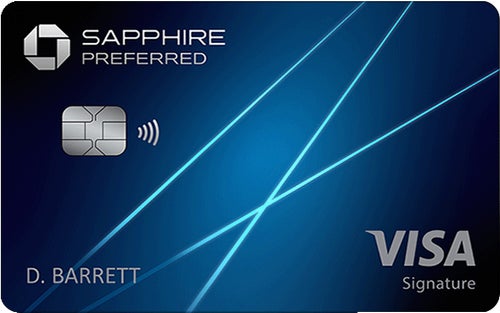Summary
The Chase Sapphire Preferred Card and Capital One Venture Card offer some of the finest travel benefits you can get on a mid-tier rewards card — especially in the first year. See what else we found when comparing the two cards.
The content on this page is accurate as of the posting date; however, some of our partner offers may have expired. Please review our list of best credit cards, or use our CardMatch™ tool to find cards matched to your needs.
If you’re willing to invest up to $95 a year in an annual fee for a credit card, the Chase Sapphire Preferred® Card and the Capital One Venture Rewards Credit Card offer some of the finest travel benefits you can get on a mid-tier rewards card — especially in the first year.
Choosing between the two travel cards, though, can be tricky — especially if you aren’t sure which card best matches your spending habits and rewards preferences.
For cardholders who travel and eat out often, the Chase Sapphire Preferred offers some enticing benefits as well as an excellent sign-up bonus. But for a cardholder who doesn’t want to put much time into tracking spending or maximizing their rewards earnings, the Venture Card’s unlimited 2X miles on every purchase is hard to beat. Here’s what else we found when comparing the two cards:
Card details
| Card |  |  |
|---|---|---|
| Rewards rate |
|
|
| Sign-up bonus | 60,000 points when you spend $4,000 in 3 months | 75,000 bonus miles when you spend $4,000 on purchases in 3 months |
| Annual fee | $95 | $95 |
| Estimated yearly rewards (with $15,900 annual spend) | $392 | $233 |
Chase Sapphire Preferred vs. Capital One Venture Card
Sign-up bonus
| Chase Sapphire Preferred | Capital One Venture Card |
|---|---|
| 60,000 points when you spend $4,000 in 3 months | 75,000 bonus miles when you spend $4,000 in 3 months |
The winner: Tie
Both cards deliver some of the best sign-up bonuses and have the same spending goal, requiring you to spend around $1,333 each month. At first glance, the Chase Sapphire Preferred’s 60,000 points seems lower than the Venture Card’s 75,000 miles. However, since Chase Ultimate Rewards points are worth 1.25 cents each when redeemed for travel through the Ultimate Rewards portal, your 60,000-point bonus is worth up to $750.
The Venture Card, meanwhile, offers 75,000 bonus miles, but since Capital One miles are worth 1 cent each, it’s also worth up to $750. Essentially, either card will bring excellent value once you reach the spending requirement.
Earning rewards
| Chase Sapphire Preferred | Capital One Venture Card |
|---|---|
|
|
The winner: Chase Sapphire Preferred
These cards are inherently different, making them difficult to compare on rewards alone. The Capital One Venture Card offers an unlimited 2-mile bonus on every purchase, allowing you to stockpile miles each time you shop or pay a bill using your card. You’d be surprised how quickly and how easily the flat rate earns you rewards. It does offer bonus miles on travel booked through Capital One Travel, but it’s limited to only hotels and rental cars.
On the other hand, the Chase Sapphire Preferred earns 5X points on all travel booked through the Chase portal and if you must book elsewhere, you’ll still get 2X points on general travel. The 3X points on dining, select streaming services and online grocery purchase also make good use of some key everyday categories. And since points are worth 1.25 cents per point with the Sapphire Preferred, it potentially earns more than with the Venture Card.
Redemption flexibility
| Chase Sapphire Preferred | Capital One Venture Card |
|---|---|
|
|
The winner: Tie
You can tell from the above table, but the Sapphire Preferred Card offers a few more redemption options. Not only can you redeem the typical ways — statement credit, cash back and gift cards — but also for more issuer-specific redemptions like Chase Experiences, which give you exclusive access to sporting events, concerts and famous restaurants. And of course, like many other mid-tier travel cards, you can transfer points, at varying rates, to Chase’s airline and hotel partners. This is a big plus if you’re already stockpiling airline or hotel loyalty points and could use an infusion of rewards.
The Capital Venture Card has fewer redemption options than the Sapphire Preferred, but you still have many choices. Plus, the card lets you book travel yourself, on any travel website you choose and will reimburse you with a statement credit as long as you redeem within 90 days. That provides a lot of flexibility if you’re a bargain hunter who regularly scans third-party sites for the cheapest flights and hotel rooms. Capital One has its own transfer partners as well, over 15 of them, but there are no major U.S. airlines on the list.
Travel insurances and other perks
| Chase Sapphire Preferred | Capital One Venture Card |
|---|---|
|
|
The winner: Chase Sapphire Preferred
Overall, the Chase Sapphire Preferred offers more perks, and more valuable ones, than the Capital One Venture Card. Most notable for the Sapphire Preferred is its trip cancellation/interruption insurance, a rarity usually reserved for travel cards with higher annual fees, that provides secondary coverage on a variety of covered incidents. The card’s other important benefits include the $50 annual Ultimate Rewards Hotel Credit (which you must use up before you earn 5X points on hotels) and 10-percent annual point bonus based on your total spend each year.
Which card should you get?
The Chase Sapphire Preferred is a more lucrative card, to earn high rewards and potentially stretch your points’ value quite a lot. However, its fixed bonus categories do require more effort than the Capital One Venture Card to maximize. The flat rewards rate on the Venture Card makes it easy and straightforward to use for all purchases.
- If you want to jump into Chase Ultimate Rewards: The Sapphire Preferred is a great introduction card into one of the best rated rewards programs due to the card’s 25-percent point boost and generous rewards structure.
- If you love to travel: There’s a lot about the Sapphire Preferred that is geared toward travel — the point boost on Ultimate Rewards travel, the up to 5X points on travel purchases and the numerous travel insurances — that will surely ease your worries and make use of your vacationing.
- If you like to use one card for all purchases: The unlimited 2X miles on the Capital One Venture Rewards Card makes it easy to use the card for all your purchases, so you don’t have to give it a second thought. And you’ll be surprised how quickly your pile of points grows.
- If you prefer simplicity: When it comes down to it, the Venture Card is a simpler card than the Sapphire Preferred, but that is the Venture Card’s advantage considering how tight the competition is. The flat rewards rate, more straightforward redemption options and slimmer travel benefits make it easier to manage and maximize its value.
Bottom line
Power cardholders who don’t mind taking the time to maximize their rewards may find the Sapphire Preferred Card more enticing, especially if you’re a frequent traveler who likes to pool the points you earn from various loyalty programs. For a cardholder who’d like to earn easy rewards, without spending too much extra time, the Capital One Venture Card offers more value and is simpler to use.
Editorial Disclaimer
The editorial content on this page is based solely on the objective assessment of our writers and is not driven by advertising dollars. It has not been provided or commissioned by the credit card issuers. However, we may receive compensation when you click on links to products from our partners.





